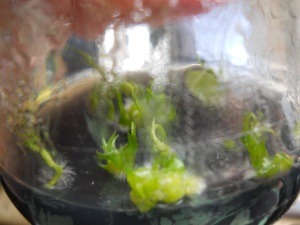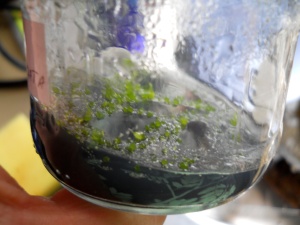Back in April, I wrote a little about the orchid in-vitro course that I was taking. Here’s the link. Well, now is the time to take those little seedlings out of the Mother Flasks and re-plate them so they have some room to grow.
Growing orchids is a whole different branch of horticulture. You can’t just take a seed, stick it in soil and expect to have a beautiful plant pop up in a few days. Mother nature can do that but us mortals have to take some very specific steps to get one of these beauties to grow. Here is a short course of “asymbiotic germination”. Fancy word huh 🙂
- To get orchid seeds, first you must hand pollinate the orchid and wait for the seed pod to mature. This can take anywhere from a month to over a year to get a seed pod. Even then you are never sure if the seeds inside are viable and will grow an orchid plant.
- Once you have orchid seeds you will need to sew them in a sterile environment. Don’t try to do this when you have a cold because one sneeze and poof, your orchid seeds are gone! They are so tiny they are little more than dust particles! To sew the seeds you need:
- Sterile flasks with specialized growing medium
- A sterile area in which to work such as a glove box
- Sterile instruments
- Bleach, alcohol, distilled sterile water
- sterilized seeds (yep, even the seeds need to be sterile, one little spec of bacteria, fungus or any other nasty and all your efforts have got to waste)
Once you’ve done all this, and trust me this is a very short synopsis of what is needed, you hopefully end up with this, some lovely little protocorms ready to be re-plated.

This is showing good growth with viable seeds that have produced seedlings.
Here’s a picture where very few of the seeds were viable, but at least I did get a couple of seeds to germinate 🙂

If you look closely, you will see 3 little green sprouts, the other bumpy little bits are little clumps of seeds that weren’t viable. See how tiny the seeds actually are?
This picture shows some great germination but these little guys still need more growth before they can be re-plated and as you can see these were actually started before the other two flasks.

So now it’s been about 4 months and the first flask that I showed you needs to be re-plated. This basically means taking them out of the original growing medium (that’s the black stuff you see in the bottom of the flasks) and putting them into some fresh growing medium in with more room to grow. This too has to be done in a completely sterile environment otherwise you risk getting fungus & other gunk in with the little orchids. Since these other icky things will grow faster than the orchids, they will take over and kill all your little beauties.
So that, in a very tiny nut shell, is what I’ve been doing and where I’m at today with my orchid seeds.
The next step, after about a year or so in the re-plating flasks, the seedlings will have to be planted into community pots. This step doesn’t need to be sterile, but you still have to disinfect everything or once again you put your baby orchids at risk.
In about 5 years I’ll have some beautiful orchids that are of blooming size!!
Here is what the orchids pictured above are supposed to look like when they are all grown up.

This is Stanhopea graveolens. These orchids need to be grown in a hanging basket because although the leaves grow upward, the flowers come out from the bottom of the plant 🙂

Stanhopea inodora, this large, robust species usually has big pseudobulbs, fragrant, waxy flowers, and large sepals. The lip is usually white and sepals and petals greenish-white.
These so far are one of my favorite orchids, the flowers look like spiders all standing in a line 🙂
So, why am I telling you all this? Well for one thing I love orchids and the process of growing them and wanted to share it with you all, but also to let you know that the store will be closed tomorrow. I’ll be in Kitchener for the continuation of my orchid course and doing some re-plating of the plants you see above.
Keep your fingers crossed for me that I don’t mess up. Please feel free to leave comments, I love comments, or ask any questions. I’m no expert by any means, but I have learned a little something that I may be able to pass on.
Take care,
Sherry
